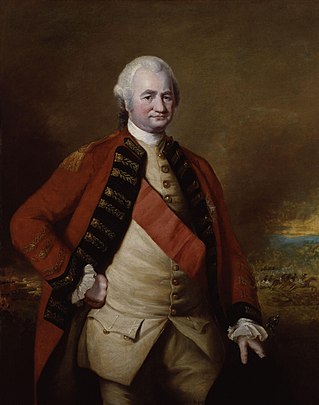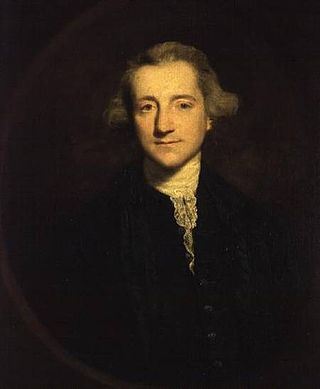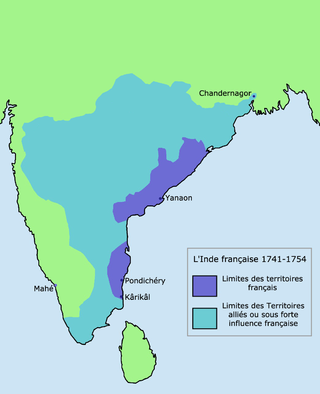
1757 (MDCCLVII) was a common year starting on Saturday of the Gregorian calendar and a common year starting on Wednesday of the Julian calendar, the 1757th year of the Common Era (CE) and Anno Domini (AD) designations, the 757th year of the 2nd millennium, the 57th year of the 18th century, and the 8th year of the 1750s decade. As of the start of 1757, the Gregorian calendar was 11 days ahead of the Julian calendar, which remained in localized use until 1923.

Warren Hastings was a British colonial administrator, who served as the first Governor of the Presidency of Fort William (Bengal), the head of the Supreme Council of Bengal, and so the first Governor-General of Bengal in 1772–1785. He and Robert Clive are credited with laying the foundation of the British Empire in India. He was an energetic organizer and reformer. In 1779–1784 he led forces of the East India Company against a coalition of native states and the French. In the end, the well-organized British side held its own, while France lost influence in India. In 1787, he was accused of corruption and impeached, but he was eventually acquitted in 1795 after a long trial. He was made a Privy Councillor in 1814.

Robert Clive, 1st Baron Clive,, also known as Clive of India, was the first British Governor of the Bengal Presidency. Clive has been widely credited for laying the foundation of the British East India Company (EIC) rule in Bengal. He began as a writer for the EIC in 1744 and established Company rule in Bengal by winning the Battle of Plassey in 1757. In return for supporting the Nawab Mir Jafar as ruler of Bengal, Clive was guaranteed a jagir of £30,000 per year which was the rent the EIC would otherwise pay to the Nawab for their tax-farming concession. When Clive left India in January 1767 he had a fortune of £180,000 which he remitted through the Dutch East India Company.

Lieutenant-General Sir Eyre Coote, KB was an Anglo-Irish military officer and politician who sat in the House of Commons from 1768 to 1780. He is best known for his many years of service with the British Army in India. His victory at the Battle of Wandiwash is considered a decisive turning point in the struggle for control in India between Britain and France. He was known by his sepoy troops as Coote Bahadur.

The Battle of Plassey was a decisive victory of the British East India Company, under the leadership of Robert Clive, over the Nawab of Bengal and his French allies on 23 June 1757. Robert Clive was paid £1 million by the Jagat Seth family - a rich Indian family business group - to defeat Siraj-ud-Daulah. The victory was made possible by the defection of Mir Jafar, Nawab Siraj-ud-Daulah's commander in chief who was also paid by the Jagat Seths. The battle helped the British East India Company take control of Bengal in 1772. Over the next hundred years, they continued to expand their control over vast territories in the rest of the Indian subcontinent, including Burma.

Mirza Muhammad Siraj-ud-Daulah, commonly known as Siraj-ud-Daulah or Siraj ud-Daula, was the last independent Nawab of Bengal. The end of his reign marked the start of the rule of the East India Company over Bengal and later almost all of the Indian subcontinent.

Fort William is a fort in Hastings, Calcutta (Kolkata). It was built during the early years of Britain's administration of Bengal. It sits on the eastern banks of the River Hooghly, the major distributary of the River Ganga. One of Kolkata's most enduring British-era military fortifications, other than those in Bombay (Mumbai) and Madras (Chennai), it extends over an area of seventy hectares.

The Bengal Presidency, officially the Presidency of Fort William in Bengal and later Bengal Province, was a province of British India and the largest of all the three Presidencies. At the height of its territorial jurisdiction, it covered large parts of what is now South Asia and Southeast Asia. Bengal proper covered the ethno-linguistic region of Bengal. Calcutta, the city which grew around Fort William, was the capital of the Bengal Presidency. For many years, the Governor of Bengal was concurrently the Governor-General of India and Calcutta was the capital of India until 1911.
Kolkata was a colonial city. The British East India Company developed Calcutta as a city by establishing an artificial riverine port in the 18th century CE. Kolkata was the capital of the British India until 1911, when the capital was relocated to Delhi. Kolkata grew rapidly in the 19th century to become the second most important city of the British Empire after London and was declared as the financial (commercial) capital of the British India. This was accompanied by the development of a culture that fused Indian philosophies with European tradition.

Henry Vansittart was an English colonial administrator, who was the Governor of Bengal from 1759 to 1764.

The Nawab of Bengal was the hereditary ruler of Bengal Subah in Mughal India. In the early 18th-century, the Nawab of Bengal was the de facto independent ruler of the three regions of Bengal, Bihar and Orissa which constitute the modern-day sovereign country of Bangladesh and the Indian states of West Bengal, Bihar and Odisha. The Bengal Subah reached it's peak during the reign of Nawab Shuja-ud-Din Muhammad Khan. They are often referred to as the Nawab of Bengal, Bihar and Orissa. The Nawabs were based in Murshidabad which was centrally located within Bengal, Bihar, and Odisha. Their chief, a former prime minister, became the first Nawab. The Nawabs continued to issue coins in the name of the Mughal Emperor, but for all practical purposes, the Nawabs governed as independent monarchs. Bengal continued to contribute the largest share of funds to the imperial treasury in Delhi. The Nawabs, backed by bankers such as the Jagat Seth, became the financial backbone of the Mughal court.

Mir Syed Jafar Ali Khan Bahadur was a commander-in-chief or military general who reigned as the first dependent Nawab of Bengal of the British East India Company. His reign has been considered by many historians as the start of the expansion of British control of the Indian subcontinent in Indian history and a key step in the eventual British domination of vast areas of pre-partition India.

Omichund, Omichand, or Umichand was a merchant and broker during the Nawabi period of Bengal. He was one of the principal authors of the conspiracy against Nawab and associated with the treaty negotiated by Robert Clive before the Battle of Plassey in 1757.

The Carnatic wars were a series of military conflicts in the middle of the 18th century in India's coastal Carnatic region, a dependency of Hyderabad State, India. The first Carnatic wars were fought between 1740 and 1748.

Vice Admiral Charles Watson was an officer of the Royal Navy, who served briefly as colonial governor of Newfoundland, and died in Calcutta, India.
Adwaita, also spelled Addwaita, was a male Aldabra giant tortoise that lived in the Alipore Zoological Gardens of Kolkata, India. At the time of his death in 2006, Adwaita was believed to be amongst the longest-living animals in the world.

The siege of Calcutta was a battle between the Bengal Subah and the British East India Company on 20 June 1756. The Nawab of Bengal, Siraj ud-Daulah, aimed to seize Calcutta to punish the company for the unauthorised construction of fortifications at Fort William. Siraj ud-Daulah caught the Company unprepared and won a decisive victory.

The Battle of Chinsurah, also known as the Battle of Biderra or the Battle of Hoogly, was a military engagement which took place on 25 November 1759 near Chinsurah during the Seven Years' War. It took place between a force of British troops mainly of the British East India Company and a force of the Dutch East India Company which had been invited by the Nawab of Bengal Mir Jafar to help him expel the British and establish themselves as the leading commercial company in Bengal.

The Battle of Chandannagar (Chandernagore) was a successful attack on the French-held settlement of Chandernagore by a British force under the command of Robert Clive and Charles Watson on 23 March 1757 during the Seven Years' War. Chandernagore remained under military occupation by the British until the signing of the Treaty of Paris in 1763, which brought an end to the war.

The Bengal Subah, also referred to as Mughal Bengal, was the largest subdivision of the Mughal Empire encompassing much of the Bengal region, which includes modern-day Bangladesh, the Indian state of West Bengal, and some parts of the present-day Indian states of Bihar, Jharkhand and Odisha between the 16th and 18th centuries. The state was established following the dissolution of the Bengal Sultanate, a major trading nation in the world, when the region was absorbed into the Mughal Empire. Bengal was the wealthiest region in the Indian subcontinent.
















